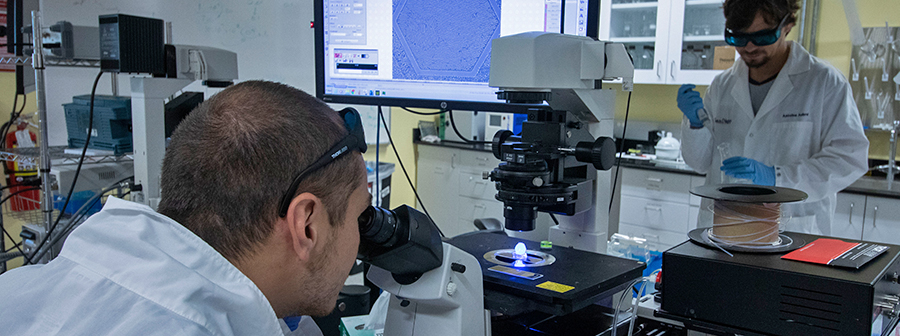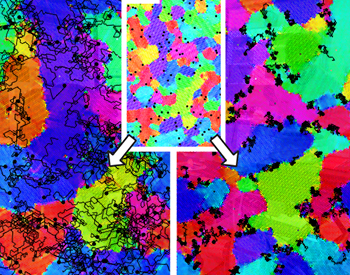 Members of the Palacci Lab observe an experiment through a microscope. Photo by Michelle Fredricks, UC San Diego Physical Sciences
Members of the Palacci Lab observe an experiment through a microscope. Photo by Michelle Fredricks, UC San Diego Physical Sciences
Making Noise to Heat Up Materials Science
September 20, 2019 | By Cynthia Dillon
 Simulation showing that how the active intruders move impacts how annealing occurs. Graphics courtesy of Jérémie Palacci
Simulation showing that how the active intruders move impacts how annealing occurs. Graphics courtesy of Jérémie Palacci
Clashing swords make for a lot of small- and big-screen drama—both in sound and structure of the weapons. The pliable strength of these tools comes from the way they are made—heating up metal until it’s red hot, then cooling it off in a controlled way to obtain the desired sword-like properties. Technically, this process is called annealing, and it is at the heart of the latest work by Jérémie Palacci, soft matter physicist at UC San Diego.
The research by Palacci and his colleagues, as outlined recently in Nature Communications, involves active microparticles in a passive monolayer of micrometric beads. Essentially by adding particles the researchers turn up the volume on internal activity. This “heating” from inside can control materials and lay the groundwork for further development of materials science beyond equilibrium—the static or passive state.
Instead of actually cranking up the temperature to remove the defects in the crystalline structure, Palacci and his former lab members, Sophie Ramananarivo and Etienne Ducrot, embedded a small fraction of active agents—“doped” particles or “active intruders”—inside the crystalline structures.
“The passive particles are lazy, they barely move, and the crystalline structure is stuck with defects,” explained Palacci. “The active particles, on the other hand, are very mobile and energized—they run around, bumping into everything—so that only a small number of them generates enough mess to agitate the structure and anneal the whole crystal.”
According to the researchers, since the activity of the active particles can be controlled with light, the team was able to control the annealing at the microscale, offering the first experimental demonstration of a man-made material internally controlled by active noise.
“We just added one percent more particles—without actually changing the temperature. The added particles make a mess that infuses enough energy to fix all the defects,” said Palacci.
The UC San Diego assistant professor of physics noted that the team even realized that how the active intruders run around matters. According to Palacci, it made the effect a lot more subtle and interesting than just cranking up the heat “like they did in olden times.”
“The control of internal fluctuations paves the way to the tuning of material properties, as well as the engineering of bio-inspired sensors, harnessing active noise for enhanced accuracy,” said Ramananarivo.
This research was supported by the National Science Foundation (grant nos. DMR-1554724 and DMR-1610788), the Sloan Foundation (grant no. FG-2017-9392) and the NYU IT High Performance Computing resources, services and staff.

